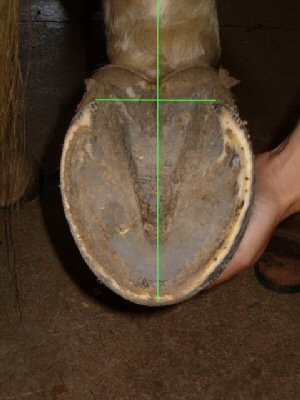
Have We Forgotten the Back Hooves?
Share
There is so much advice on the importance of balancing the front hooves, but rarely do we read stuff on balancing the back hooves.
The rear of the horse is where the "engine" is. So if the 'engine' of the horse isn't right, then the locomotion is going to be off in some manner.
If the back hooves are not balanced with as much care as the fronts, then the 'engine' of the horse is going to be 'off'.
It's that simple.
If your horse is having issues with the stifle, the SI joint, the hocks (think of twisting hocks), is feeling short-strided in the back or 'choppy' without full impulsion, or if your horse has issues fully striding out and extending, these can all be caused from imbalanced BACK HOOVES.
How are the rear hooves connected to the SI, the hocks, the stifles, and the back in general?
What is the first part of the horse to move when asking the horse to walk off?
It's the back ... AND then the hooves! But if the back hooves are imbalanced - too low, thrushy, sore etc, then the back muscles are going to tighten up along with the rest of the hind quarters, which will contract and bunch up and disallow the horse to move out comfortably in fully-extended strides. So, from there, all sorts of issues can develop.
Let's take a quick look at the rear hooves.
Many are used to seeing back hooves that look like this:

You can see how the angle is 'broken back' (at the point of the arrow); this shows that the heels are lower than the toe.This puts tremendous strain on the tendons and ligaments in the lower leg which, in turn, will affect all the way up to the SI and the back as a whole.
This condition is known as a 'broken hoof-pastern axis', or "broken back" angle.
The hoof below shows a nice, straight angle right through the P1/P2 joint, the P2/P3 joint and down the hoof, itself, to the ground:

Can you see the difference? This is a nicely balanced rear hoof that serves the horse and his rider well.
Here we have what's called a "bull nosed" hoof: (photo from American Farriers Journal). 
The red line designates the negative palmar angle of the P3 ... the bulge on the dorsal hoof wall (front of hoof) shows the 'bull nose' that is an external indicator of negative palmar angle.
Here is a nice straight angle to the dorsal hoof wall:

Do you recognize any of these situations?
Rear hooves that are imbalanced medial-laterally (side-to-side when looking at the hoof from the front), can cause suspensory injuries, fetlock lameness, and hock and tibia (the long bone between the hock and stifle) pain.
What you would see with an medial-lateral imbalance would be similar to what you see here:

And, looking from the heel view, one can ascertain imbalance by looking at the heel bulbs (uneven in size and angle), heels (one higher than the other, and as such, one wall longer than the other ...

And then we have the sheared hoof:

Can you see how skewed this hoof looks from the rear?
Below I've pasted a decently balanced hoof in the solar view. See how a line drawn right down the middle of the hoof from toe to heel intersects squarely with the line drawn from heel to heel? There's another way to assess the balance medial-laterally when the heels and the anterior-posterior center line (from toe to back of hoof) form a nice "T" or 90 degree angle.

There are other ways to assess the balance of your horse's hooves. If you'd like to learn more click barefoot trim)
"Rear hoof imbalances are not well-understood. “Instead of causing foot pain directly, rear feet seem to cause many more problems higher up the leg—to the hocks, stifles, glutes, sacroiliac joint,” said Turner. Therefore, addressing these asymmetries is just as important for treating or preventing lameness as it is in the front hooves. In closing, he emphasized the importance of radiographs when assessing rear imbalances, keeping in mind the natural differences in rear hoof shape and alignment."
So now you have some good visuals to compare to your own horses' hooves. Take another look at this post HERE to read even more signs of imbalances in the equine hoof.
Now, put them all together and what do you see?
As noted above, the hoof landmarks will give you far more ways to assess your horses' hooves. But remember, when your horse goes 'off' in some manner, it might be a good idea to take a look at the hooves first!
Building a Supportive Barefoot Community
The team at Scoot Boot believe passionately in the barefoot horse and strive to build a supportive community of barefoot horse lovers.
Find more information about using Scoot Boots here.

Gwen Santagate is the author of "10 Secrets to Healthy Hooves" . For the last 37+ years, she has maintained healthy hooves with natural trimming on thousands of horses and specialized in pathological rehabilitation hoofcare for the last 18 years. She keeps a small herd of her own equines and continues to offer consults for horses in need.

